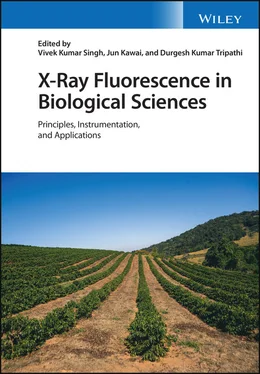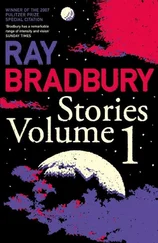X-Ray Fluorescence in Biological Sciences
Здесь есть возможность читать онлайн «X-Ray Fluorescence in Biological Sciences» — ознакомительный отрывок электронной книги совершенно бесплатно, а после прочтения отрывка купить полную версию. В некоторых случаях можно слушать аудио, скачать через торрент в формате fb2 и присутствует краткое содержание. Жанр: unrecognised, на английском языке. Описание произведения, (предисловие) а так же отзывы посетителей доступны на портале библиотеки ЛибКат.
- Название:X-Ray Fluorescence in Biological Sciences
- Автор:
- Жанр:
- Год:неизвестен
- ISBN:нет данных
- Рейтинг книги:5 / 5. Голосов: 1
-
Избранное:Добавить в избранное
- Отзывы:
-
Ваша оценка:
- 100
- 1
- 2
- 3
- 4
- 5
X-Ray Fluorescence in Biological Sciences: краткое содержание, описание и аннотация
Предлагаем к чтению аннотацию, описание, краткое содержание или предисловие (зависит от того, что написал сам автор книги «X-Ray Fluorescence in Biological Sciences»). Если вы не нашли необходимую информацию о книге — напишите в комментариях, мы постараемся отыскать её.
Discover a comprehensive exploration of X-ray fluorescence in chemical biology and the clinical and plant sciences X-Ray Fluorescence in Biological Sciences: Principles, Instrumentation, and Applications
X-Ray Fluorescence in Biological Sciences: Principles, Instrumentation, and Applications
X-Ray Fluorescence in Biological Sciences — читать онлайн ознакомительный отрывок
Ниже представлен текст книги, разбитый по страницам. Система сохранения места последней прочитанной страницы, позволяет с удобством читать онлайн бесплатно книгу «X-Ray Fluorescence in Biological Sciences», без необходимости каждый раз заново искать на чём Вы остановились. Поставьте закладку, и сможете в любой момент перейти на страницу, на которой закончили чтение.
Интервал:
Закладка:
66 66 Revenko, A.G., Suvorova, D.S., and Khudonogova, E.V. (2018). Investigation of filter applicability for XRF analysis in the longwave range. Anal. Control 22 (2): 117–127. https://doi.org/10.15826/analitika.2018.22.2.009(in Russian).
67 67 Sahin, Y., Nas, S., and Gokalp, H.Y. (1991). Effect of shooting period, region of growth and processing method on the Fe and Mn content of tea determined by X‐ray fluorescence. Int. J. Food Sci. Technol. 26: 485–492.
68 68 Nas, S., Gokalp, H.Y., and Sahin, Y. (1993). K and Ca content of fresh green tea, black tea, and tea residue determined by X‐ray fluorescence analysis. Z. Lebensm. Unters. Forsch. 196: 32–37.
69 69 Xie, M., von Bohlen, A., Klockenkämper, R. et al. (1998). Multielement analysis of Chinese tea (Camellia sinensis) by total‐reflection X‐ray fluorescence. Z. Lebensm. Unters. Forsch. A 207: 31–38.
70 70 Salvador, M.J., Lopes, G.N., Filho, V.F.N., and Zucchi, O.L.A.D. (2002). Quality control of commercial tea by X‐ray fluorescence. X‐Ray Spectrom. 31 (2): 141–144.
71 71 Brytov, I.A., Plotnikov, R.I., and Rechinsky, A.A. (2005). Material identification by X‐ray spectra. Industrial Lab. Diagn. Mater. 71 (7): 11–17 (In Russian).
72 72 Tanizawa, Y., Abe, T., and Yamada, K. (2007). Black tea stain formed on the surface of teacups and pots. Part 1 – study on the chemical composition and structure. Food Chem. 103 (1): 1–7.
73 73 Ercilsi, S., Demir, F., Budak, G., and Karabulut, A. (2009). Determination of elemental variations in tea leaves (Camellia sinensis L.) in different harvest time by WDXRF spectrometry. Asian J. Chem. 21 (2): 1313–1317.
74 74 Wastowski, A.D., Gonsiorkiewicz, R.J.P., Cherubin, M.R. et al. (2013). Determination of the inorganic constituents of commercial teas and their infusions by the technique of energy dispersive X‐ray fluorescence spectrometry. J. Med. Plant Res. 7: 179–185.
75 75 Afonin, V.P., Gunicheva, T.N., and Piskunova, L.F. (1984). X‐Ray Fluorescence Silicate Analysis. Novosibirsk: Nauka (in Russian).
76 76 Borkhodoev, V.Ya. (1999). X‐Ray Fluorescence Analysis of Rocks by Fundamental Parameter Method. Magadan: NEISRI FEB RAS (in Russian).
77 77 Pavlinsky, G.V. (2008). Fundamentals of X‐Ray Physics. Cambridge: International Science of Publishing Ltd.
78 78 Li, X. and Yu, Z. (2016). Determination of selenium in biological samples with an energy‐dispersive X‐ray fluorescence spectrometer. Appl. Radiat. Isot. 111: 45–49.
79 79 Rajapaksha, D., Waduge, V., and Padilla‐Alvarez, R. (2017). XRF to support food traceability studies: classification of Sri Lankan tea based on their region of origin. X‐Ray Spectrom. 46 (4): 220–224.
80 80 Dalipi, R., Borgese, L., and Tsuji, K. (2018). Elemental analysis of teas, herbs and their infusions by means of total reflection X‐ray fluorescence. J. Food Compos. Anal. 67: 128–134.
81 81 Cruz, R., Morais, S., and Casa, S. (2015). Mineral composition variability of coffees: a result of processing and production. In: Processing and Impact on Active Components in Food (ed. V.R. Preedy), 549–557. Elsevier. Chapter 66.
82 82 Orlic, I., Makanic, J., and Valkovic, V. (1986). Optimization of XRFS for the analysis of toxic elements and heavy metals in coffee products. J. Radioanal. Nucl. Chem. 102 (1): 203–211.
83 83 Ninomiya, T. (2004). X‐Ray Spectrometry in Forensic Research. X‐Ray Spectrometry: Recent Technological Advances (eds. K. Tsuji et al.), Kouichi Tsuji, Jasna Injuk, Rene Van Grieken (Eds.) 553–567. Wiley.
84 84 Akamine, T., Otaka, A., Hokura, A. et al. (2010). Determination of trace elements in coffee beans by XRF spectrometer equipped with polarization optics and its application to identification of their production area. Bunseki Kagaku 59 (10): 863–871.
85 85 Debastiani, R., dos Santos, C.E.I., Yoneama, M.L. et al. (2014). Ion beam analysis of ground coffee and roasted coffee beans. Nucl. Instrum. Methods Phys. Res. B. 318: 202–206.
86 86 Hernandez, M.C., Romero, D., Torres, H. et al. (2017). X‐ray fluorescence analysis of ground coffee. J. Nucl. Phys. Mater. Sci. Rad. Appl. 5 (1): 25–34.
87 87 Debastiani, R., dos Santos, C.E., Ramos, M.M. et al. (2019). Elemental analysis of Brazilian coffee with ion beam techniques: from ground coffee to the final beverage. Food Res. Int. 119: 297–304.
88 88 Maltsev, A.S., Sharykina, D.S., Chuparina, E.V. et al. (2019). Multielement analysis of tea by total reflection X‐ray fluorescence spectrometry. Anal. Control 23 (2): 247–257. (in Russian).
89 89 Dalipi, R., Margui, E., Borgese, L., and Depero, L. (2017). Multi‐element analysis of vegetal foodstuffs by means of low power total reflection X‐ray fluorescence (TXRF) spectrometry. Food Chem. 218: 348–355.
90 90 Revenko, A.G., Losev, N.F., and Velichko, J.I. (1972). Die Methode zur Rontgenspektralаnalyse fur mehrkomponentige Proben unter Benutzung von zwei Entnahme‐winkeln der Fluoreszenzstrahlung. Vortrage der Tagung "Die Rontgen‐spektrometrie und ihre Bedeutung als Analysenmethode, Berlin, 106–128.
91 91 Revenko, A.G., Pavlinsky, G.V., and Losev, N.F. (1972). Study of relation of X‐ray fluorescence intensities with analyzing element concentrations in multicomponent samples. Industrial Lab. 38 (12): 1451–1458 (In Russian).
92 92 Pavlinsky, G.V., Velichko, Y.I., and Revenko, A.G. (1977). Program for calculating the intensity of X‐ray fluorescence spectrum. Industrial Lab. 43 (4): 433–436 (In Russian).
93 93 Pavlinsky, G.V. and Kitov, B.I. (1979). Influence of divergence of the primary radiation beam on the line intensity of the X‐ray fluorescence spectrum. X‐Ray Spectrom. 8 (3): 96–101.
94 94 Velichko, Y.I. and Revenko, A.G. (1979). Use of theoretical intensities in quantitative X‐ray spectral analysis. Review. Apparat. Methods X‐Ray. Anal. 22: 146–161 (In Russian).
95 95 Revenko, A.G. (2002). X‐ray fluorescence analysis of rocks, soils and sediments. X‐Ray Spectrom. 31 (3): 264–273.
96 96 Revenko, A.G. (2010). Estimation and account for matrix effects in studying glass materials of cultural heritage by X‐ray spectral analysis. X‐Ray Spectrom. 39 (1): 63–69.
97 97 Pashkova, G.V. and Revenko, A.G. (2013). Choice of conditions for the natural water analysis using a total reflection X‐ray fluorescence spectrometer. Anal. Control 17 (1): 10–20. (in Russian).
98 98 Pashkova, G.V., Revenko, A.G., and Finkelshtein, A.L. (2013). Study of factors affecting the results of natural water analyses by total reflection X‐ray fluorescence. X‐Ray Spectrom. 42 (6): 524–530.
99 99 Suvorova, D.S., Khudonogova, E.V., and Revenko, A.G. (2016). Development of the XRF determination technique for the Ga, Hf, and Ta contents in rare earth ores. Anal. Control 20 (4): 344–354. (in Russian).
100 100 Finkel'shtein, A.L. and Afonin, V.P. (1986). Calculation of the intensity of X‐ray fluorescence. S.V. Lontsikh, Ed. In: Methods of X‐Ray Analysis, 5–11. Novosibirsk: Nauka Publishers (in Russian).
101 101 Govindaraju, K. (1994). Compilation of working values and sample description for 383 geostandards. Geostand. Newslett. Spec. Issue 18: 1–158.
4 Total Reflection X‐Ray Fluorescence and it’s Suitability for Biological Samples
N.L. Mishra1,2,* and Sangita Dhara1,2
1 Fuel Chemistry Division, Bhabha Atomic Research Centre, Mumbai, India
2 Homi Bhabha National Institute, Mumbai, India
4.1 Introduction
Determination of different elements in ultra‐trace and trace amounts in biological systems is of great importance. These elements may be essential, which are required in certain amounts for smooth biological functioning or may be non‐essential and responsible for certain types of diseases if present in body. The essential elements may be a part of some enzymes and affect the chemical interactions in biological systems [1]. Some elements such as cadmium (Cd), nickel (Ni), arsenic (As), beryllium (Be), and chromium (Cr) are carcinogenic and have toxic effects on human and animal health, whereas accumulation of some elements in trace amounts such as zinc (Zn), strontium (Sr), and lead (Pb) in cartilages affects the progression of arthritis [2–3]. Several types of minerals and trace essential elements such as Zn, Fe, Cu, etc. also act as catalytic or structural components of large biochemical molecules and are thus essential trace elements, whereas some metallic elements are used in dental and medical materials and devices [4]. In addition, some toxic elements get introduced into the biological system from contaminated food, polluted air or water and cause harmful effects to human beings or animals. Determinations of such elements are very important to correlate them with the observed biological diseases or effects. Some of the elements, present in drinking water, vegetables, and food products, are essential for human and animals, whereas some may be toxic to biological systems if taken in more than the specified quantities. The extent of toxicity and dietary requirement of these elements, for inherent dangers and good progression of human life, determines the specifications of the elements in various biological systems. In view of the role played by these elements in biological processes, the determination of concentration of these elements in above materials is very important. The classical methods used for such determinations are mostly destructive and damage the cell tissue samples. Moreover, they require a comparatively large amount of sample and are thus not well suited for analysis of biological samples which are normally available only in very small quantities. This is because getting large amount of such samples, even in mg levels, is difficult in most cases and destruction of the sample inhibits the study of distribution of trace elements and other properties in the biological cells. Moreover, the samples once used, especially in inductively coupled plasma with optical emission spectroscopy (ICP‐OES) and inductively coupled plasma mass spectrometric (ICP‐MS) analysis, are completely consumed and not available for analysis again, if required, for re‐checking in case of any doubt in the results. Therefore, a rapid and non‐destructive/non‐consumptive method of elemental analysis of biological samples is required. X‐ray fluorescence (XRF) analysis provides useful elemental information about specimens without causing specimen damage with simple sample preparations. The determination of the required elements in biological systems can be done in a non‐destructive manner using XRF [5, 6].
Читать дальшеИнтервал:
Закладка:
Похожие книги на «X-Ray Fluorescence in Biological Sciences»
Представляем Вашему вниманию похожие книги на «X-Ray Fluorescence in Biological Sciences» списком для выбора. Мы отобрали схожую по названию и смыслу литературу в надежде предоставить читателям больше вариантов отыскать новые, интересные, ещё непрочитанные произведения.
Обсуждение, отзывы о книге «X-Ray Fluorescence in Biological Sciences» и просто собственные мнения читателей. Оставьте ваши комментарии, напишите, что Вы думаете о произведении, его смысле или главных героях. Укажите что конкретно понравилось, а что нет, и почему Вы так считаете.











